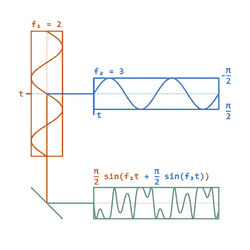Phase modulation
| Passband modulation |
|---|
| Analog modulation |
| Digital modulation |
| Hierarchical modulation |
| Spread spectrum |
| See also |
|
Phase modulation (PM) is a modulation pattern that encodes information as variations in the instantaneous phase of a carrier wave.
The phase of a carrier signal is modulated to follow the changing voltage level (amplitude) of modulation signal. The peak amplitude and frequency of the carrier signal remain constant, but as the amplitude of the information signal changes, the phase of the carrier changes correspondingly. The analysis and the final result (modulated signal) are similar to those of frequency modulation.
Phase modulation is widely used for transmitting radio waves and is an integral part of many digital transmission coding schemes that underlie a wide range of technologies like Wi-Fi, GSM and satellite television.
Phase modulation is closely related to frequency modulation (FM); it is often used as an intermediate step to achieve FM. Mathematically both phase and frequency modulation can be considered a special case of quadrature amplitude modulation (QAM).
PM is used for signal and waveform generation in digital synthesizers, such as the Yamaha DX7 to implement FM synthesis. A related type of sound synthesis called phase distortion is used in the Casio CZ synthesizers.
Theory

PM changes the phase angle of the complex envelope in direct proportion to the message signal.
Suppose that the signal to be sent (called the modulating or message signal) is and the carrier onto which the signal is to be modulated is
Annotated:
- carrier(time) = (carrier amplitude)*sin(carrier frequency*time + phase shift)
This makes the modulated signal
This shows how modulates the phase - the greater m(t) is at a point in time, the greater the phase shift of the modulated signal at that point. It can also be viewed as a change of the frequency of the carrier signal, and phase modulation can thus be considered a special case of FM in which the carrier frequency modulation is given by the time derivative of the phase modulation.
The modulation signal could here be
The mathematics of the spectral behavior reveals that there are two regions of particular interest:
- For small amplitude signals, PM is similar to amplitude modulation (AM) and exhibits its unfortunate doubling of baseband bandwidth and poor efficiency.
- For a single large sinusoidal signal, PM is similar to FM, and its bandwidth is approximately
- ,
- where and is the modulation index defined below. This is also known as Carson's Rule for PM.
Modulation index
As with other modulation indices, this quantity indicates by how much the modulated variable varies around its unmodulated level. It relates to the variations in the phase of the carrier signal:
- ,
where is the peak phase deviation. Compare to the modulation index for frequency modulation.
See also
- Angle modulation
- Automatic frequency control
- Modulation for a list of other modulation techniques
- Polar modulation
- Electro-optic modulator for Pockel's Effect phase modulation for applying sidebands to a monochromatic wave